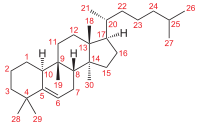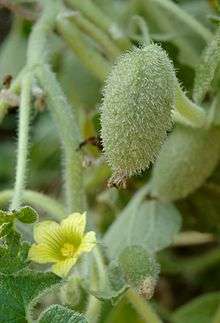Cucurbitacin

Cucurbitacin is any of a class of biochemical compounds that some plants — notably members of the family Cucurbitaceae, which includes the common pumpkins and gourds — produce and which function as a defence against herbivores. Cucurbitacins are chemically classified as steroids, formally derived from cucurbitane, a triterpene hydrocarbon — specifically, from the unsaturated variant cucurbita-5-ene, or 19-(10→9β)-abeo-10α-lanost-5-ene. They often occur as glycosides.[1] They and their derivatives have been found in many plant families (including Brassicaceae, Cucurbitaceae, Scrophulariaceae, Begoniaceae, Elaeocarpaceae, Datiscaceae, Desfontainiaceae, Polemoniaceae, Primulaceae, Rubiaceae, Sterculiaceae, Rosaceae, and Thymelaeaceae), in some mushrooms (including Russula and Hebeloma) and even in some marine mollusks.
Cucurbitacins may be a taste deterrent in plants foraged by some animals and in some edible plants preferred by humans, like cucumbers. In laboratory research, cucurbitacins have cytotoxic properties and are under study for their potential biological activities.[2][3]
Biosynthesis
The biosynthesis of Cucurbitacin C has been described recently. Zhang et al. (2014) identified nine cucumber genes in the pathway for biosynthesis of cucurbitacin C and elucidated four catalytic steps.[4] These authors also discovered the transcription factors Bl (Bitter leaf) and Bt (Bitter fruit) that regulate this pathway in leaves and fruits, respectively. The Bi gene confers bitterness to the entire plant and is genetically associated with an operon-like gene cluster, similar to the gene cluster involved in thalianol biosynthesis in Arabidopsis. Fruit bitterness requires both Bi and the dominant Bt (Bitter fruit) gene. Nonbitterness of cultivated cucumber fruit is conferred by bt, an allele selected during domestication. Bi is a member of the oxidosqualene cyclase (OSC) gene family. Phylogenetic analysis showed that Bi is the ortholog of cucurbitadienol synthase gene CPQ in squash (Cucurbita pepo) [4]
Variants
The cucurbitacins include:
Cucurbitacin A

- Cucurbitacin A found in some species of Cucumis [1]:1
- Pentanorcucurbitacin A, or 22-hydroxy-23,24,25,26,27-pentanorcucurbit-5-en-3-one C
25H
40O
2, white powder[5]:1
- Pentanorcucurbitacin A, or 22-hydroxy-23,24,25,26,27-pentanorcucurbit-5-en-3-one C
Cucurbitacin B

- Cucurbitacin B from Hemsleya endecaphylla (62 mg/72 g)[6]:4 and other plants (e.g. Cucurbita andreana[7]); anti-inflammatory, any-hepatotoxic [1]:2
- Cucurbitacin B 2-O-glucoside, from Begonia heracleifolia [1]:3
- 23,24-Dihydrocucurbitacin B from Hemsleya endecaphylla, 49 mg/72 g[6]:5
- 23,24-Dihydrocucurbitacin B 2-O-glucoside from roots of Picrorhiza kurrooa [1]:4
- Deacetoxycucurbitacin B 2-O-glucoside from roots of Picrorhiza kurrooa [1]:5
- Isocucurbitacin B, from Echinocystis fabacea [1]:6
- 23,24-Dihydroisocucurbitacin B 3-glucoside from Wilbrandia ebracteata [1]:7
- 23,24-Dihydro-3-epi-isocucurbitacin B, from Bryonia verrucosa [1]:8
- Pentanorcucurbitacin B or 3,7-dioxo-23,24,25,26,27-pentanorcucurbit-5-en-22-oic acid, C
25H
36O
4, white powder[5]:2
Cucurbitacin C
Cucurbitacin D

- Cucurbitacin D, from Trichosanthes kirilowii and many other plants [1] (e.g. Cucurbita andreana[7]):12
- 3-Epi-isocucurbitacin D, from species of Physocarpus [1]:14 and Phormium tenax[8]
- 22-Deoxocucurbitacin D from Hemsleya endecaphylla, 14 mg/72 g[6]:6
- 23,24-Dihydrocucurbitacin D from Trichosanthes kirilowii [1]:13 also from H. endecaphylla, 80 mg/72 g[6]:3
- 23,24-Dihydro-epi-isocucurbitacin D, from Acanthosicyos horridus [1]:20
- 22-Deoxocucurbitacin D from Wilbrandia ebracteata [1]:21
- Anhydro-22-deoxo-3-epi-isocucurbitacin D from Ecballium elaterium [1]:22
- 25-O-Acetyl-2-deoxycucurbitacin D (amarinin) from Luffa amara [1]:24
- 2-Deoxycucurbitacin D, from Sloanea zuliaensis [1]:23
Cucurbitacin E
- Cucurbitacin E (aelaterin), from roots of Wilbrandia ebracteata. Strong antifeedant for the flea beetle, inhibits cell adhesion [1] (also in e.g. Cucurbita andreana[7]):27
- 22,23-Dihydrocucurbitacin E from Hemsleya endecaphylla, 9 mg/72 g,[6]:8 and from roots of Wilbrandia ebracteata [1]:28
- 22,23-Dihydrocucurbitacin E 2-glucoside from roots of Wilbrandia ebracteata [1]:29
- Isocucurbitacin E, from Cucumis phrophetarum [1]:30
- 23,24-Dihydroisocucurbitacin E, from Cucumis phrophetarum [1]:31
Cucurbitacin F
- Cucurbitacin F from Elaeocarpus dolichostylus [1]:33
- Cucurbitacin F 25-acetate from Helmseya graciliflora [1]:34
- 23,24-Dihydrocucurbitacin F from Helmseya amabilis [1]:35
- 25-Acetoxy-23,24-dihydrocucurbitacin F from Helmseya amabilis (hemslecin A) [1]:36
- 23,24-Dihydrocucurbitacin F glucoside from Helmseya amabilis [1]:40
- Cucurbitacin II glucoside from Helmseya amabilis [1]:41
- Hexanorcucurbitacin F from Elaeocarpus dolichostylus [1]:43
- Perseapicroside A from Persea mexicana [1]:44
- Scandenoside R9 from Hemsleya panacis-scandens [1]:45
- 15-Oxo-cucurbitacin F from Cowania mexicana [1]:46
- 15-oxo-23,24-dihydrocucurbitacin F from Cowania mexicana [1]:47
- Datiscosides B, D, and H, from Datisca glomerata [1]:48–50
Cucurbitacin G
- Cucurbitacin G from roots of Wilbrandia ebracteata [1]:52
- 3-Epi-isocucurbitacin G, from roots of Wilbrandia ebracteata [1]:54
Cucurbitacin H
- Cucurbitacin H, stereoisomer of cucurbitacin G, from roots of Wilbrandia ebracteata [1]:53
Cucurbitacin I

- Cucurbitacin I (elatericin B) from Hemsleya endecaphylla, 10 mg/72 g,[6]:7 also from Ecballium elaterium,[1] Citrullus colocynthis,[1] Cucurbita andreana,[7] deters feeding by flea beetle [1]:55
- Hexanorcucurbitacin I from Ecballium elaterium [1]:56
- 23,24-Dihydrocucurbitacin I see Cucurbitacin L
- Khekadaengosides D and K from the fruits of Trichosanthes tricuspidata [1]:57,58
- 11-Deoxocucurbitacin I, from Desfontainia spinosa [1]:59
- Spinosides A and B, from Desfontainia spinosa [1]:61,62
- 23,24-dihydro-11-Deoxocucurbitacin I from Desfontainia spinosa [1]:60
Cucurbitacin J
- Cucurbitacin J from Iberis amara [1]:69
- Cucurbitacin J 2-O-β-glucopyranoside from Trichosanthes tricuspidata [1]:71
Cucurbitacin K
- Cucurbitacin K, stereoisomer of cucurbitacin J,[9]:2 from Iberis amara [1]:70
- Cucurbitacin K 2-O-β-glucopyranoside from Trichosanthes tricuspidata [1]:72
Cucurbitacin L
- Cucurbitacin L, or 23,24-dihydrocucurbitacin I,[1]:63 [9]:1
- Brydioside A from Bryonia dioica [1]:64
- Bryoamaride from Bryonia dioica [1]:65
- 25-O-Acetylbryoamaride from Trichosanthes tricuspidata [1]:66
- Khekadaengosides A and B from Trichosanthes tricuspidata [1]:67–68
Cucurbitacin O
- Cucurbitacin O from Brandegea bigelovii [1]:73
- Cucurbitacin Q 2-O-glucoside, from Picrorhiza kurrooa [1]:76
- 16-Deoxy-D-16-hexanorcucurbitacin O from Ecballium elaterium [1]:77
- Deacetylpicracin from Picrorhiza scrophulariaeflora [1]:78
- Deacetylpicracin 2-O-glucoside from Picrorhiza scrophulariaeflora [1]:80
- 22-Deoxocucurbitacin O from Wilbrandia ebracteata [1]:83
Cucurbitacin P
- Cucurbitacin P from Brandegea bigelovii [1]:74
Cucurbitacin Q

- Cucurbitacin Q from Brandegea bigelovii [1]:75
Cucurbitacin R
- Cucurbitacin R is actually 23,24-dihydrocucurbitacin D.[1]
Cucurbitacin S
- Cucurbitacin S from Bryonia dioica [1]:84'85
Cucurbitacin T
- Cucurbitacin T, from the fruits of Citrullus colocynthis [1]:86
28/29 Norcucurbitacins
There are several substances that can be seen as derving from cucurbita-5-ene skeleton by loss of one of the methyl groups (28 or 29) attached to carbon 4; often with the adjacent ring (ring A) becoming aromatic.[1]:87–130
Other
Several other cucurbitacins have been found in plants.[1]:152–156,164–165
Occurrence
Constituents of the colocynth fruit and leaves (Citrullus colocynthis) include cucurbitacins.[10][11]
The 2-O-β-D-glucopyranosides of cucurbitacins K and L can be extracted with ethanol from fruits of Cucurbita pepo cv dayangua.[9]
Pentanorcucurbitacins A and B can be extracted with methanol from the stems of Momordica charantia.[5]
Cucurbitacins B and I, and derivatives of cucurbitacins B, D and E, can be extracted with methanol from dried tubers of Hemsleya endecaphylla.[6]
Bitter taste
Cucurbitacins impart a bitter taste in plant foods such as cucumber, melon and pumpkin.[12]
Deaths
Pathologists found cucurbitacin in the stomach of a 79-year-old man who died in Bavaria, Germany, shortly after eating a casserole containing zucchini he had received from a neighbor. The "Chemische- und Veterinäruntersuchungsamt Stuttgart" (chemical and veterinary research authority) found cucurbitacin in a sample of the casserole the man had eaten shortly before his death. Maria Roth of that agency said that recent hot weather had likely stressed the plant, causing more toxin than usual to be present.[13][14]
See also

- Goyaglycoside
- Hemslecin
- Mogroside
- Momordicine
- Momordicoside
- Neomogroside
- Scandenosides R1–R8,R10-R11 [1]:172–181
- Siamenoside I [1]:182
References
- 1 2 3 4 5 6 7 8 9 10 11 12 13 14 15 16 17 18 19 20 21 22 23 24 25 26 27 28 29 30 31 32 33 34 35 36 37 38 39 40 41 42 43 44 45 46 47 48 49 50 51 52 53 54 55 56 57 58 59 60 61 62 63 64 65 66 67 68 69 70 71 72 73 74 Jian Chao Chen, Ming Hua Chiu, Rui Lin Nie, Geoffrey A. Cordell and Samuel X. Qiu (2005), "Cucurbitacins and cucurbitane glycosides: structures and biological activities" Natural Product Reports, volume 22, pages 386-399 doi:10.1039/B418841C
- ↑ Alghasham, AA (2013). "Cucurbitacins - a promising target for cancer therapy". International Journal of Health Sciences. 7 (1): 77–89. doi:10.12816/0006025. PMC 3612419
 . PMID 23559908.
. PMID 23559908. - ↑ Kapoor, S (2013). "Cucurbitacin B and Its Rapidly Emerging Role in the Management of Systemic Malignancies Besides Lung Carcinomas". Cancer Biotherapy & Radiopharmaceuticals. 28 (4): 359. doi:10.1089/cbr.2012.1373. PMID 23350897.
- 1 2 Zhang, Y.; et al. (2014). "Biosynthesis, regulation, and domestication of bitterness in cucumber". Science. 346 (6213): 1084–1088. doi:10.1126/science.1259215. PMID 25430763.
- 1 2 3 Chen, Chiy-Rong; Liao, Yun-Wen; Wang, Lai; Kuo, Yueh-Hsiung; Liu, Hung-Jen; Shih, Wen-Ling; Cheng, Hsueh-Ling; Chi-I, Chang (2010). "Cucurbitane Triterpenoids from Momordica charantia and Their Cytoprotective Activity in tert-Butyl Hydroperoxide-Induced Hepatotoxicity of HepG2 Cells". Chemical & Pharmaceutical Bulletin. 58 (12): 1639–1642. doi:10.1248/cpb.58.1639.
- 1 2 3 4 5 6 7 Chen, Jian-Chao; Zhang, Gao-Hong; Zhang, Zhong-Quan; Qiu, Ming-Hua; Zheng, Yong-Tang; Yang, Liu-Meng; Yu, Kai-Bei (2008). "Octanorcucurbitane and Cucurbitane Triterpenoids from the Tubers of Hemsleya endecaphylla with HIV-1 Inhibitory Activity". J. Nat. Prod. 71 (1): 153–155. doi:10.1021/np0704396. PMID 18088099.
- 1 2 3 4 Halaweish, FT; Tallamy, DW (1993). "A new cucurbitacin profile for Cucurbita andreana: A candidate for cucurbitacin tissue culture". Journal of Chemical Ecology. 19 (6): 1135–1141. doi:10.1007/BF00987375. PMID 24249132.
- ↑ Kupchan, S.Morris; Meshulam, Haim; Sneden, Albert T. (1978). "New cucurbitacins from Phormium tenax and Marah oreganus". Phytochemistry. 17 (4): 767–769. doi:10.1016/S0031-9422(00)94223-7.
- 1 2 3 Wang, Da-Cheng; Pan, Hong-Yu; Deng, Xu-Ming; Xiang, Hua; Gao, Hui-Yuan; Cai, Hui; Wu, Li-Jun (2007). "Cucurbitane and hexanorcucurbitane glycosides from the fruits of Cucurbita pepo cv dayangua".". Journal of Asian Natural Products Research. 9 (6): 525–529. doi:10.1080/10286020600782538.
- ↑ Song, F; Dai, B; Zhang, H. Y.; Xie, J. W.; Gu, C. Z.; Zhang, J (2015). "Two new cucurbitane-type triterpenoid saponins isolated from ethyl acetate extract of Citrullus colocynthis fruit". Journal of Asian Natural Products Research. 17 (8): 813–8. doi:10.1080/10286020.2015.1015999. PMID 25761128.
- ↑ Chawech, R; Jarraya, R; Girardi, C; Vansteelandt, M; Marti, G; Nasri, I; Racaud-Sultan, C; Fabre, N (2015). "Cucurbitacins from the Leaves of Citrullus colocynthis (L.) Schrad". Molecules. 20 (10): 18001–15. doi:10.3390/molecules201018001. PMID 26437392.
- ↑ Shang, Y; Ma, Y; Zhou, Y; Zhang, H; Duan, L; Chen, H; Zeng, J; Zhou, Q; Wang, S; Gu, W; Liu, M; Ren, J; Gu, X; Zhang, S; Wang, Y; Yasukawa, K; Bouwmeester, H. J.; Qi, X; Zhang, Z; Lucas, W. J.; Huang, S (2014). "Plant science. Biosynthesis, regulation, and domestication of bitterness in cucumber". Science. 346 (6213): 1084–8. doi:10.1126/science.1259215. PMID 25430763.
- ↑ "Mann stirbt an Garten Zucchini". Retrieved 24 August 2015.
- ↑ "Auf den Geschmack kommt es an". Retrieved 24 August 2015.